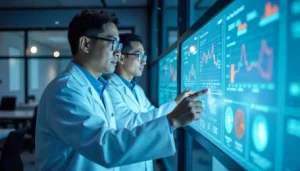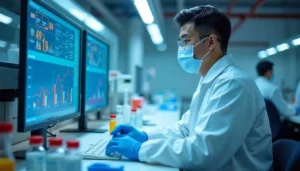Introduction
In the fast-paced world of Fast-Moving Consumer Goods (FMCG), maintaining quality control is essential to uphold customer trust and satisfaction. Visual inspection solutions have emerged as a vital tool for enhancing quality control processes in the FMCG industry. In this article, we’ll delve into the significance of visual inspection solutions, their benefits, and how they contribute to elevating the overall quality of FMCG products. In the dynamic world of FMCG, where products fly off the shelves in a matter of days, maintaining consistent quality can be a daunting task. Visual inspection solutions have stepped in as a reliable method to ensure that each product meets the highest quality standards before reaching consumers.
The Importance of Quality Control in FMCG
Quality control is the backbone of any successful FMCG business. Consumers expect products to be of the highest quality every time they make a purchase. Inadequate quality control can lead to dissatisfied customers, brand erosion, and financial losses.
Challenges in Traditional Quality Control Methods
Traditional quality control methods often rely on manual inspections, which can be time-consuming, labor-intensive, and prone to human errors. With the speed at which FMCG products are produced, manual inspections can lead to bottlenecks in the production process.
The Emergence of Visual Inspection Solutions
Visual inspection solutions have emerged as a response to the limitations of traditional methods. These solutions use cutting-edge technologies to analyze products with precision and speed, ensuring that defects are identified in real time.
Key Technologies Driving Visual Inspection
Machine Vision Systems
Machine vision systems use cameras, sensors, and software to capture and analyze images of products. These systems can identify even the tiniest defects that might go unnoticed by the human eye.
Artificial Intelligence and Deep Learning
Artificial Intelligence (AI) and deep learning algorithms have revolutionized visual inspection. These algorithms can be trained to recognize various defects and anomalies, making the inspection process more accurate over time.
Automation and Robotics
Automation and robotics have further enhanced visual inspection. Robotic arms can manipulate products for a thorough analysis, and automated systems can process a large number of products in a short time.
Benefits of Visual Inspection Solutions
Enhanced Defect Detection
Visual inspection solutions catch defects that might be missed by manual inspections. This includes defects in color, shape, size, and texture.
Improved Accuracy and Consistency
Machines are consistent in their inspections, eliminating human errors. This leads to a higher level of accuracy and uniformity in quality control.
Increased Operational Efficiency
Visual inspection solutions speed up the quality control process, allowing businesses to maintain a high production rate without compromising quality.
Implementing Visual Inspection in FMCG
Customization for Product Types
Visual inspection systems can be customized to suit different types of FMCG products, ensuring that each product is inspected based on its unique attributes.
Integration with Production Lines
Integration with production lines ensures that every product is inspected without causing disruptions to the production process.
Real-time Monitoring and Reporting
Real-time monitoring allows businesses to identify defects as they occur, preventing defective products from entering the market.
Overcoming Challenges and Limitations
Complex Product Variability
FMCG products come in various shapes, sizes, and materials. Visual inspection solutions must be adaptable to handle this variability.
Initial Setup Costs
While visual inspection solutions offer long-term benefits, the initial investment can be substantial. However, the return on investment through improved quality and efficiency justifies the cost.
Continuous System Upgrades
As technology evolves, visual inspection solutions require periodic updates and upgrades to remain effective.
The Future of Visual Inspection in FMCG
With ongoing advancements in AI, machine learning, and automation, the future of visual inspection in FMCG looks promising. Manufacturers can expect even higher levels of accuracy and efficiency.
Conclusion
Visual inspection solutions have revolutionized quality control in the FMCG industry. By leveraging technology, businesses can ensure that every product leaving their facilities meets the highest standards, leading to customer satisfaction and brand loyalty. Trident Information Systems have designed Vision Intelligence System considering manufacturer’s grievances and how we can push them ahead in the market competition. With a dedicated team of experts, we have managed to accomplish a robust track of accomplishments. You too can implement this Machine Vision System and see the results for yourself. Contact us for further information or a demonstration.
FAQs
- Are visual inspection solutions suitable for all types of FMCG products? Yes, visual inspection solutions can be customized to accommodate various product types.
- Can visual inspection catch defects that are not visible to the human eye? Yes, machine vision can identify defects that might be too small for manual inspections.
- Do visual inspection systems require constant monitoring? Visual inspection systems offer real-time monitoring, but they can also operate autonomously.
- What is the typical ROI of implementing visual inspection solutions? The ROI can vary based on factors like production volume and defect rate, but it’s generally substantial.
- How will AI contribute to the evolution of visual inspection? AI will enable more sophisticated defect recognition and adaptive learning, enhancing accuracy over time.







